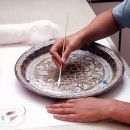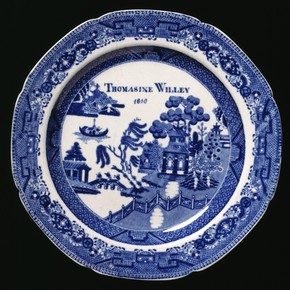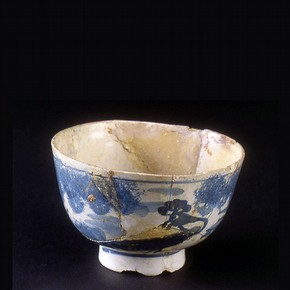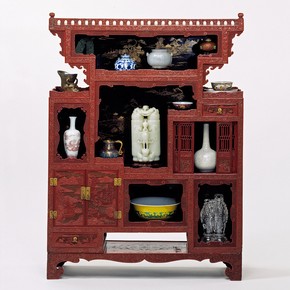3 Answers
Caring for your Ceramics
This section contains information and advice on how to look after ceramics. It highlights common problems, tells you what to avoid and provides practical, step-by-step instructions on how to clean and care for ceramic objects.
Types of ceramic
Ceramics include all objects made from clay which are shaped when wet and hardened by heating (firing). Fired clay has been used to create both functional and decorative objects since prehistoric times. In general, the higher the firing temperatures, the more durable and less porous the ceramic can be.
The ceramic body can be left unglazed after the initial 'biscuit' firing. Glaze can be applied prior to subsequent lower temperature firing. Glazes produce a decorative glassy finish on the ceramic that provides an impermeable coating to strengthen the ceramic, making it less or even non-porous and thus suitable for storing liquids.
Click on the images below to find out how to clean ceramics:
- <a title="Cleaning glazed earthenware, glazed stoneware." href="http://www.vam.ac.uk/__data/assets/image/0015/260070/cleaning.jpg" rel="#popup">
 </a>
</a> - <a title="Black basalt vase, about 1785. Museum no. 1506-1855" href="http://www.vam.ac.uk/__data/assets/image/0016/260071/basalt.jpg" rel="#popup">
 </a>
</a> - <a title="Figure with basket, About 1758-70. Museum no. C.156-1931" href="http://www.vam.ac.uk/__data/assets/image/0004/260293/figurine.jpg" rel="#popup">
 </a>
</a> 
- <a title="Tin glazed earthenware plate (back view), Italy" href="http://www.vam.ac.uk/__data/assets/image/0019/260074/white_plate.jpg" rel="#popup">
 </a>
</a> 

- <a title="Glazed earthenware tile, Mexico. Salts are visible as long white needles around the unglazed edges" href="http://www.vam.ac.uk/__data/assets/image/0015/260313/unglazed-tile.jpg" rel="#popup">
 </a>
</a>
Damage through cleaning
Do not use a dishwasher to clean valued ceramics. High temperatures, high pressure water and aggressive detergents can permanently damage glazes and coloured enamel decoration.
Avoid using household bleaches or proprietary cleaning products because they can cause irreversible damage. Cleaning liquid can penetrate the ceramic, taking dirt with it. This can cause new stains or make old stains worse. Often the effect is not noticeable until the object has dried. Abrasive creams and cleaners will damage delicate decoration such as gilding, lustre or enamels and in the worst case, dull the glaze itself.
Breakages and repairs
Faults can occur during manufacture as a result of the constituents of the clay or glaze, poor fabrication techniques (e.g. how well a handle was attached) or inconsistencies in the firing process. Areas of inherent vulnerability include firing cracks, crazing or pits in the glaze. Many inherent problems in ceramics are directly related to the type of ceramic body and decoration, for example the porosity of earthenware means that it is prone to staining if it gets wet.
Restorations and repairs
Old repairs often indicate structural weakness and can disguise problems underneath. Some modern resins allow breaks to be joined almost invisibly. If the join hasn't been retouched, you should be able to spot it using a magnifying glass. Areas of loss will have often been filled with plaster or resin materials and then painted to disguise them. Often the paint will have discoloured over time.
In some cases, the whole object may have been coated with paint or lacquer as the last step in its restoration - at first glance this may look like the glaze but feels somewhat 'plastic'. Some porcelain restorations can be spotted by holding the object up to the light, where many repaired breaks or filled areas will appear darker than the original.
Accidental breakage
If you are likely to make an insurance claim, photograph the scene of the accident before anything is moved. Collect all the fragments, no matter how small. Fragments can travel quite a distance after impact, so look carefully to find all the pieces.
Place larger pieces into a tray or box, padding or loosely wrapping them with clean tissue or acid-free paper. Use self-sealing bags for small pieces. Avoid sticky labels, which can be difficult to remove. Try not to touch the broken edges as fingermarks can make it difficult to bond the pieces. Resist the urge to try to fit any pieces back together - edges are always fragile. Consult a ceramics conservator for the best possible repair.
Repairing ceramics
In theory bonding a broken ceramic back together should be straightforward, but the sheer number of poor quality repairs found - misaligned edges, adhesive that has stained porous ceramic bodies, or lumps of excess adhesive along the break line - highlight the problems that can be encountered. Sometimes the damage caused by amateur repairs can be irreversible. If you value your ceramic, leave bonding of broken pieces to a conservator.
One of the reasons for difficulties with home repairs is that common household adhesives are inappropriate. Some are too thick or rapidly discolour, whilst others bond almost instantaneously, giving one brief chance to get it right. All such products are hard to remove and will make any future repair work more difficult and time consuming. Ceramics conservators often use specialist adhesives that are not readily available to the public.
Storing
Ceramics can usually tolerate a wide range of environmental conditions without being damaged. There are some notable exceptions, e.g. ceramics in which salts are dormant but where problems will be initiated by fluctuating relative humidity.
In rare cases, there may be a manufacturing fault that can cause cracks to develop in the body or crazing in the glaze, particularly where there are sudden changes in temperatures, for example from direct sunlight or spotlights.
Lastly, old restorations or repairs may be more vulnerable to the environment. For example, some restoration materials used to fill or retouch a loss may discolour if exposed to strong light or if stored in the dark.
However, the main cause of damage to ceramics is impact damage. Try to avoid displaying ceramics in areas where there is passing traffic or where you may need access behind them, for example window sills in front of an opening window.
Display cabinets are a good option. If several pieces are displayed together, make sure they are not too crowded and aren't touching each other. Avoid hanging pieces by their handles, as these are often a weak point, particularly if they have been damaged or repaired in the past.
Vibration can be a problem when displaying ceramics. A busy road outside or foot falls on a springy floor inside a home can cause ceramics to 'creep' and they may bump into other pieces or fall from the shelf. One way to prevent creep is to place a piece of chamois leather under the ceramic. This is also a good way of stopping ceramics with an uneven base from wobbling. Avoid rough surfaces as they can scratch the base.
Commercially available display or mounting waxes are another way to prevent creep, but take care to ensure that the product does not stain your object. It should not be used on a porous ceramic (see Types of ceramic) or display surface. Always use sparingly as the wax is messy to remove. Take a small amount and make it into 3-4 (minute) balls, place at regular intervals underneath the ceramic and press down gently. To remove the ceramic from display, hold it firmly by its base and turn gently. Residues can be removed with a piece of tissue paper barely dampened with water.. Too much liquid can draw residues into the ceramic body.
Mounts for ceramics
Mounts are often used to show decorative ceramics that are in good condition but they aren't always suitable for cracked or restored pieces. Mounts need to be the right size for the piece - if they are too tight they can chip the edges, whilst if they are too large they won't hold the piece securely. Padding a mount with a thin cushioning material where it is in contact with the edge of a ceramic may be advisable.
Museums often use inert plastic (e.g. Perspex) for mounts, as seen here, but there are many other safe options. Proprietary adjustable plastic hangers, called wall plate stands, wooden display stands and grooved shelves in display cupboards are all suitable. Plastic coated metal sprung plate hangers should only be used if the dish is in good condition. Do not use bare metal hangers as these can cause scratches or chips and will stain the ceramic if it corrodes. Avoid mounts with hard sharp edges or using metal pins to stop plates sliding forward, as they can chip or scratch unless they are padded.
Produced by the V&A Ceramics and Glass Conservation Studio.
Ceramics can be divided into three main categories defined by their firing temperatures and the constituents of the clay:
Read full article here>>http://www.vam.ac.uk/content/articles/c/caring-for-your-ceramics/
| 8 years ago. Rating: 3 | |

 Mary Ann Cealah
Mary Ann Cealah
 country bumpkin
country bumpkin



 coakley2003
coakley2003






